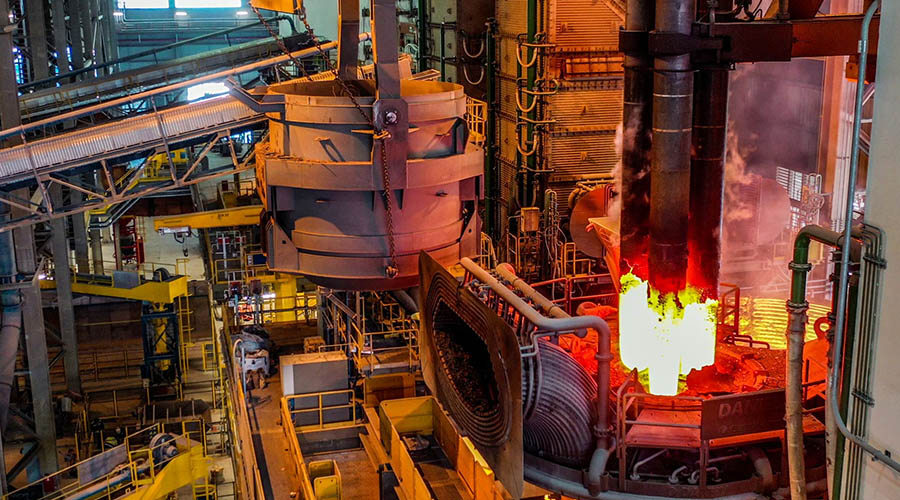EAF steelmaking of graphite electrode can be divided into five stages as a whole: raw material collection, preparation before smelting, melting period, oxidation period, and reduction period.
1. Collection of Raw Materials
Scrap steel is the main material for electric arc furnace steelmaking. The quality of scrap steel directly affects the quality, cost, and productivity of graphite electrodes. Therefore, the following requirements are made for scrap steel:
(1) The scrap surface shall be clean and less rusty, because the sediment and other sundries in the scrap will reduce the conductivity of the furnace charge, prolong the melting time, and affect the dephosphorization effect in the oxidation period, and erode the furnace lining. When the scrap is seriously rusted or stained with oil, the yield of steel and alloy elements will be reduced and the hydrogen content in steel will be increased.
(2) The scrap shall not be mixed with lead, tin, arsenic, zinc, copper, and other non-ferrous metals. Lead has a high density, low melting point, is insoluble in molten steel, and is easy to deposit in the gap at the bottom of the furnace, resulting in breakout accidents. Tin, arsenic, and copper are easy to cause hot embrittlement of steel.
(3) The scrap shall not be mixed with sealed containers, inflammable, explosives, and poisons to ensure safe production.
(4) The chemical composition of scrap steel shall be clear, and the content of sulfur and phosphorus shall not be too high.
(5) The overall dimension of scrap steel shall not be too large (the sectional area shall not exceed 150mm × 150mm, and the larger length should not exceed 350mm). Pig iron is generally used to increase the carbon content of charge in electric arc furnace steelmaking, which usually does not exceed 30% of the charge.
2. Preparation before Smelting
The burden is an indispensable part of the graphite electrode steelmaking process. Whether the burden is reasonable or not is related to whether the steelmakers can carry out the smelting operation normally according to the process requirements.
A reasonable burden can shorten smelting time. Attention shall be paid to: first, the batching calculation must be carried out correctly and the furnace charge loading must be accurately weighed. Second, the size of the furnace charge shall be matched according to the proportion, so as to achieve the purpose of good loading and fast melting. Third, all kinds of furnace burden shall be used in combination with steel quality requirements and smelting methods. Fourth, the ingredients must meet the process requirements.
3. Melting Period of Graphite Electrode
In the electric arc furnace steelmaking process, the melting period is from the beginning of power on to the time when the furnace burden is completely melted. The melting period accounts for about half of the whole smelting time, and the power consumption accounts for about 2/3 of the total power consumption.
The task of the melting period is to quickly melt and heat up the furnace burden with the minimum power consumption on the premise of ensuring the service life of the furnace body, and making the slag in the burning period, so as to stabilize the arc, prevent air suction and early dephosphorization.
(1) Arc starting stage. The furnace is full of charge when the arc is energized and started, and the arc is close to the furnace top. If the input power is too large, the furnace top will be easily burned out if the voltage is too high. Therefore, the medium voltage and about 2/3 of the rated power of the input transformer are generally selected.
(2) Well-crossing stage. At this stage, the arc is completely surrounded by the furnace charge, and almost all the heat is absorbed by the furnace charge, so the furnace lining will not be burned. Therefore, higher power is used. Generally, the well penetrating time is about 20min, accounting for about 1/4 of the total melting time.
(3) Graphite electrode rising stage. After the graphite electrode “penetrates the well” to the bottom, a molten pool has been formed at the bottom of the furnace. Lime and some elements at the bottom of the furnace are oxidized, forming a layer of slag on the steel liquid level. The surrounding furnace materials continue to be melted by radiant heat. The increase of liquid steel increases the liquid level, and the graphite electrode gradually rises. At this stage, higher power is still used to transmit electric energy, accounting for about 1/2 of the total melting time.
(4) Melt the last class. After more than 3/4 of the furnace charge is melted, the arc can no longer be shielded by the furnace charge, and the high-temperature area under the three graphite electrodes has been connected. At this time, if a higher power is used for a long time, the arc will strongly damage the furnace cover and furnace wall.
The main task of the melting period is to melt the furnace charge, but in the melting period, it is not only to make good slag, but also an important operation content of the melting period. If only to meet the requirements of covering molten steel and stabilizing the arc, only 1% ~ 1.5% of the slag amount is enough. However, considering the requirements of dephosphorization, the molten slag must have certain oxidizability, alkalinity, and slag amount.

